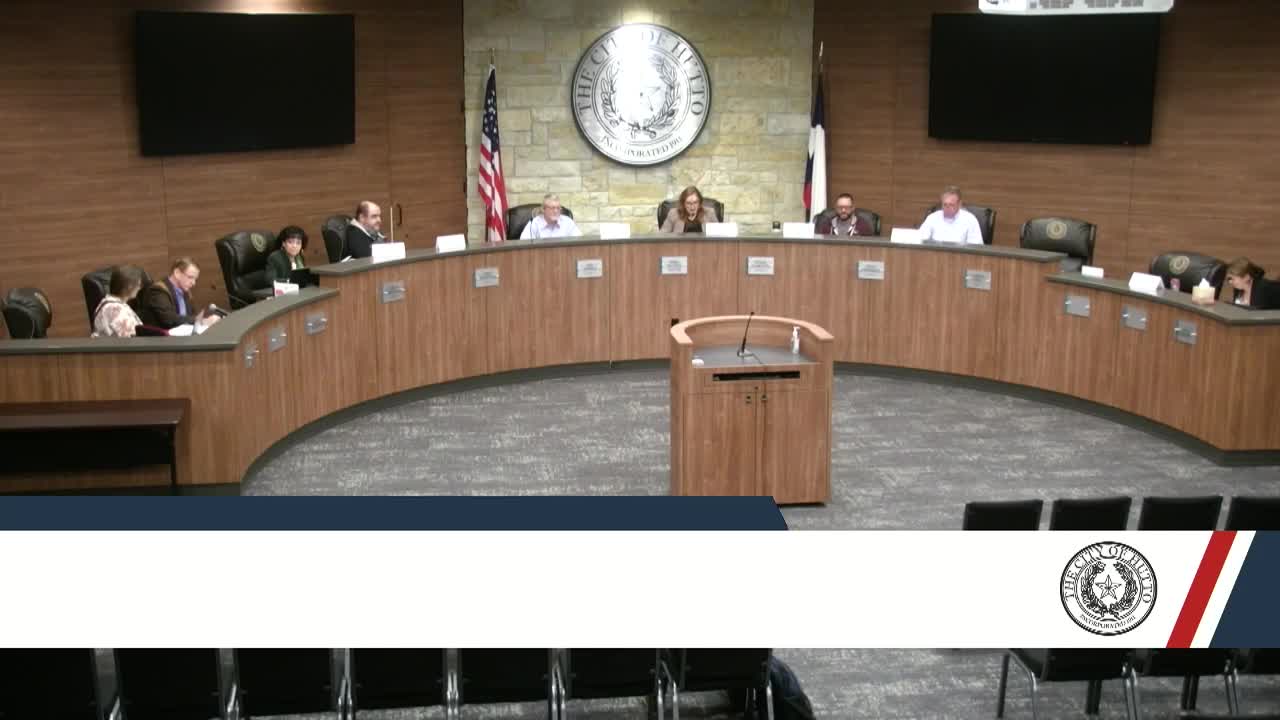Hutto EDC and city staff weigh options for Cottonwood access as Union Pacific flags 2–3 year preemption timeline
November 10, 2025 | Hutto, Williamson County, Texas
This article was created by AI summarizing key points discussed. AI makes mistakes, so for full details and context, please refer to the video of the full meeting. Please report any errors so we can fix them. Report an error »

City staff and the Hutto Economic Development Corporation board on Nov. 10 spent an extended portion of their meeting discussing access and road design for the EDC‑owned Cottonwood properties and a related traffic signal at the SH‑130/US‑79 rail crossing.
The problem and timeline
City engineering staff reported that TxDOT paused plans for a temporary traffic signal after a developer’s traffic impact analysis (TIA) prompted Union Pacific Railroad (UPRR) to require developer or city ownership of the signal design and the railroad preemption process. According to the city engineer, UPRR told staff it would take a minimum of "2 to 3 years" from final design before UPRR would sign off on the preemption required to install signals that interact with the railroad gates.
City engineer (staff) described county ballpark costs of $200,000–$250,000 for a temporary signal that did not include railroad preemption or crossing widening; the city emphasized the railroad element significantly changes cost and schedule. Staff also noted UPRR indicated a preference to remove at‑grade crossings when feasible and said the railroad had offered to help pursue Federal Railroad Administration (FRA) grants and state funds that target crossing elimination.
What board members said
Board members pressed staff on timelines and procurement. Several directors said they wanted to avoid losing development deals if projects slip because of long public procurement timelines. Others emphasized public‑safety risks at the crossing and urged staff to pursue the right long‑term solution, even if it took longer to secure funding.
Options under consideration
Staff said the immediate next step is for the city to ask an engineer on its rotation list to provide a scope, fee and schedule to evaluate temporary and permanent signal options (including the special requirements when a railroad crossing is involved). Those estimates will inform a request to finance and, if necessary, a council budget amendment or special meeting to approve funds so the design and any addenda can be issued before bid openings. If the city pursues a permanent grade separation, staff noted potential federal and state grants could offset most of the cost but would require multiyear planning.
What happens next
City staff will obtain a scope and fee from the next engineer on the rotation list, report back with price estimates and recommend whether the EDC should fund design or ask the city to fund it. Board members signaled willingness to consider funding if the project protects EDC property or accelerates critical infrastructure, but emphasized that any EDC involvement must be accompanied by clear project agreements and public‑project documentation.
Provenance: discussion and technical details introduced beginning at the Cottonwood access agenda item and spanning the public discussion and staff Q&A during item 6.6.
The problem and timeline
City engineering staff reported that TxDOT paused plans for a temporary traffic signal after a developer’s traffic impact analysis (TIA) prompted Union Pacific Railroad (UPRR) to require developer or city ownership of the signal design and the railroad preemption process. According to the city engineer, UPRR told staff it would take a minimum of "2 to 3 years" from final design before UPRR would sign off on the preemption required to install signals that interact with the railroad gates.
City engineer (staff) described county ballpark costs of $200,000–$250,000 for a temporary signal that did not include railroad preemption or crossing widening; the city emphasized the railroad element significantly changes cost and schedule. Staff also noted UPRR indicated a preference to remove at‑grade crossings when feasible and said the railroad had offered to help pursue Federal Railroad Administration (FRA) grants and state funds that target crossing elimination.
What board members said
Board members pressed staff on timelines and procurement. Several directors said they wanted to avoid losing development deals if projects slip because of long public procurement timelines. Others emphasized public‑safety risks at the crossing and urged staff to pursue the right long‑term solution, even if it took longer to secure funding.
Options under consideration
Staff said the immediate next step is for the city to ask an engineer on its rotation list to provide a scope, fee and schedule to evaluate temporary and permanent signal options (including the special requirements when a railroad crossing is involved). Those estimates will inform a request to finance and, if necessary, a council budget amendment or special meeting to approve funds so the design and any addenda can be issued before bid openings. If the city pursues a permanent grade separation, staff noted potential federal and state grants could offset most of the cost but would require multiyear planning.
What happens next
City staff will obtain a scope and fee from the next engineer on the rotation list, report back with price estimates and recommend whether the EDC should fund design or ask the city to fund it. Board members signaled willingness to consider funding if the project protects EDC property or accelerates critical infrastructure, but emphasized that any EDC involvement must be accompanied by clear project agreements and public‑project documentation.
Provenance: discussion and technical details introduced beginning at the Cottonwood access agenda item and spanning the public discussion and staff Q&A during item 6.6.
View full meeting
This article is based on a recent meeting—watch the full video and explore the complete transcript for deeper insights into the discussion.
View full meeting
